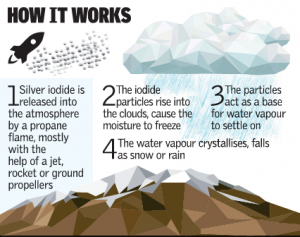Cloud seeding:
- Cloud seeding is a form of weather modification
- It is a way of changing the amount or type of precipitation that falls from clouds
- How? by dispersing substances into the air that serve as cloud condensation or ice nuclei, which alter the microphysical processes within the cloud
- Why? The usual intent is to increase precipitation (rain or snow), but hail and fog suppression are also widely practiced in airports
- Chemicals used: In cloud seeding, either dry ice, or more commonly, silver iodide aerosols are sprayed into the upper part of clouds to try to stimulate the precipitation process and form rain
- Cloud seeding also occurs due to ice nucleators in nature, most of which are bacterial in origin
- Mechanism: Since most rainfall starts through the growth of ice crystals from super-cooled cloud droplets (droplets colder than the freezing point, 32 deg. F or 0 deg. C) in the upper parts of clouds, the silver iodide particles are meant to encourage the growth of new ice particles
- The history of cloud seeding has experienced uncertain results because it can never be known whether a cloud that rains after seeding might have rained anyway
- This is because seeding is performed on clouds that look like they have some potential for producing rain
- Why in news? Maharashtra Government has approved a cloud seeding programme.
